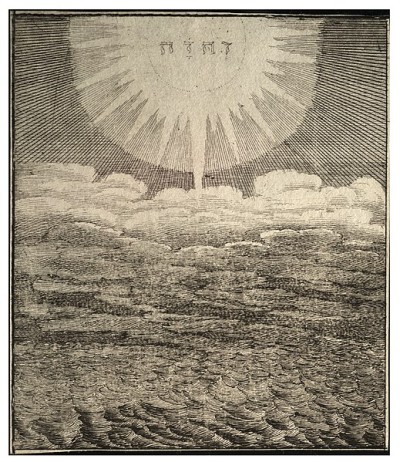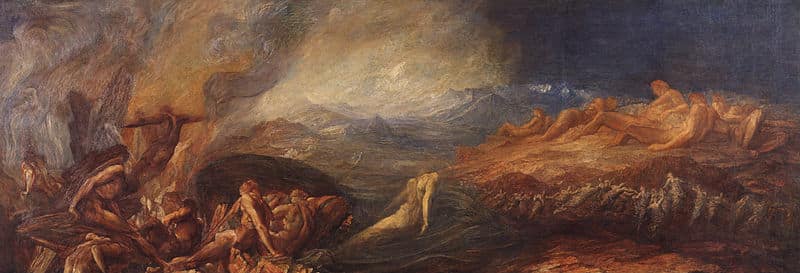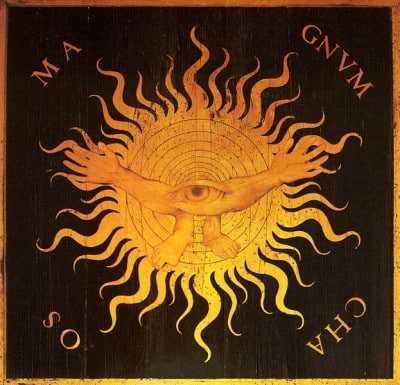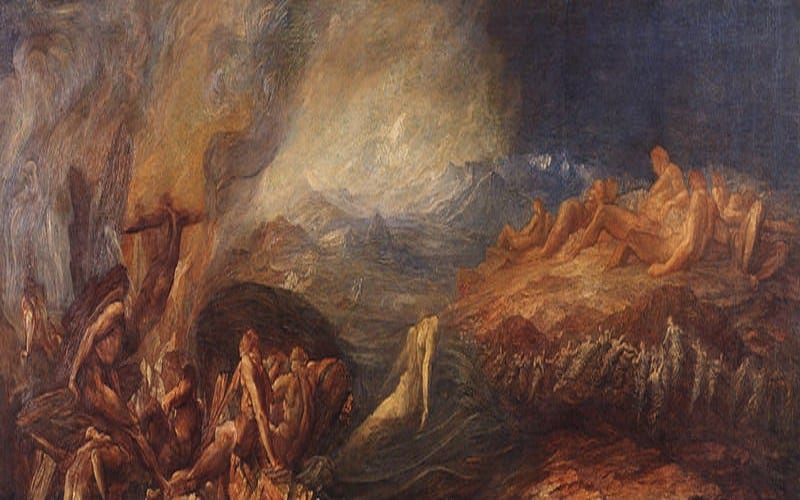Chaos was the unfathomable and ineffable space in the beginning of the time. Chaos as a concept existed in the cosmology of many cultures. In the Ancient Greek cosmology she was not only the genesis of existence but also the embodiment of the void and the space from which the universe emerged. Representing both a state of nothingness and a tangible female presence, Chaos has fascinated scholars, poets, and philosophers for centuries. Chaos is thus both a mythological figure and a concept representing the primal state of the universe before order and structure were imposed.
Chaos Key Facts
| Parents | None |
| Partners | None |
| Siblings | Gaia, Tartaros, Eros |
| Offspring | Erebos, Nyx |
| Other names | Aer |
| Greek name | Χάος |
| Roman name | Chaos |
| Best Known Myths | Creation of the Universe, Birth of Night and Darkness |
Name and Etymology
The term “Chaos” derives from the ancient Greek word “χάος” (khaos), meaning emptiness, vast void, or chasm. It is closely related to the verbs “χάσκω” (kháskō) and “χαίνω” (khaínō), which mean “to gape” or “be wide open”. This etymology reflects Chaos’s essential nature as the gaping void or the primordial abyss from which all creation sprang.
It could also mean space as in the expanse of air, that’s why Chaos was also associated with Aer (air) in some accounts. Other accounts interpret Chaos as water, in the sense that it is something without form that can be differentiated.
In Roman mythology, Chaos retains its original name and concept, although it was often less personified compared to its Greek counterpart. Chaos’s role in mythology is not merely as a personified deity but also as a conceptual space—a “receptacle of all becoming,” as Plato described it in his cosmological dialogues. This duality of being both a god and a concept underscores the complexity and significance of Chaos in ancient cosmology.
Chaos Family and Relationships
Chaos, in its primordial state, does not have parents or a lineage in the traditional sense. Herodotus in his Theogony describes that Chaos existed in the beginning, before anything else. Then came Gaia (Earth), Tartarus (the Underworld), and Eros (Love). These primordial deities could be considered something between the siblings and offspring of Chaos, since they “emerged” from Chaos but they were not actually born from her. Taking Herodotus literally, the three deities just came into being after Chaos and that cannot be considered as her offspring.
Gaia personifies the Earth and serves as the mother of many significant gods and creatures in Greek mythology. Tartarus represents the deep abyss used as a dungeon of torment and suffering for the wicked. Eros, the force of love and procreation, symbolizes the driving energy behind creation and the continuation of life.
According to most traditions, Chaos gave birth to Nyx (Night) and Erebos (Darkness) without a partner. Nyx and Erebos also gave birth to Aether (Light) and Hemera (Day). These genealogies highlight the interconnectedness of the primordial elements and their foundational role in shaping the universe.
Myths about Chaos
The Creation of Cosmos

In Hesiod’s Theogony, Chaos is the first entity to come into existence, preceding even Gaia, Tartarus, and Eros. “In truth at first Chaos came to be,” writes Hesiod, emphasizing the primordial void from which all else emerged. Only later came Gaia, the personification of Earth, Tartarus, the deep abyss, and Eros, the force of love and procreation, “fairest among the deathless gods”. This sequence highlights Chaos’s role as the source of the fundamental elements of the cosmos.
The Birth of Night and Darkness
From Chaos emerged Nyx (Night) and Erebos (Darkness). Nyx and Erebus, through their union, brought forth Aether (Light) and Hemera (Day). This lineage emphasizes the duality and balance in Greek cosmology, where light and dark, day and night, all have their origins in the primordial void of Chaos. This myth illustrates how it serves as the precursor to both the tangible and intangible elements of the universe.
Even though both Aether and Hemera were entities of light, Erebos and Nyx were dark and feared entities. It is said that Zeus himself used to fear Nyx. The offspring of the Night went forth to become a bunch of sinister children, responsible for mainly destruction and catastrophic feelings.
Chaos as a Tangible Place
As we have already discussed, Hesiod imagined Chaos as something more tangible, not just a chasm or a concept. During Titanomachy, Zeus sent off thunderbolts to hit the Titans which ended up affecting Chaos, as “astounding heat seized” her/it. It would be suggested that Chaos is a space located between Tartarus and Earth.
Depiction And Characteristics

Chaos is typically depicted as a vast, yawning void, an abyss that predates the ordered universe. This is remarkably similar to the Ginnungagap (yawning/great void) from the creation story in Norse mythology. In artistic representations, Chaos is often shown as a dark, swirling mass, emphasizing its nature as a formless and boundless entity. Unlike other deities with distinct physical forms, Chaos is more abstract, embodying the concept of emptiness and potentiality.
In terms of personality, Chaos is less anthropomorphized compared to other Greek deities. It does not exhibit human-like traits or emotions but instead represents the primal state of existence. This lack of personification aligns with Chaos’s role as a concept rather than a character with defined motives or actions. The Roman poet Ovid, in his Metamorphoses, describes Chaos as an unformed mass, a mixture of elements in a shapeless heap, reflecting the original Greek notion of a formless void.
Symbols of Chaos
Symbols associated with Chaos include the chasm or abyss, emphasizing its nature as the gap from which everything emerged. Some myths also use associations with mist or darkness, highlighting its connection to the primordial state of the universe before the separation of light and dark.
The personality of Chaos, though not detailed in mythological narratives, can be inferred through her actions and offspring. As the progenitor of Gaia, Tartarus, and Eros, and the mother of Nyx and Erebus, she embody the potential for creation and the underlying structure of the cosmos. It represents the foundational chaos from which order is derived, a theme that resonates throughout Greek mythology and cosmology.
Representations in Art
Artistic representations of Chaos are rare due to its abstract nature. However, where depicted, it is often shown as a dark, swirling void or a chasm, emphasizing its role as the primordial gap. These depictions focus on the concept as the origin of everything, rather than as a figure with a defined form.
One notable depiction is found in Renaissance art, where Chaos is sometimes illustrated as a tumultuous, formless mass of elements. These works often draw inspiration from Ovid’s description in the Metamorphoses, portraying it as an unformed mixture of earth, air, fire, and water. See, for example:
- “Chaos” by George Frederic Watts.
- “Chaos” by Wenceslaus Hollar.
- “Magnum Chaos” by Giovan Francesco Capoferri.
Modern interpretations of Chaos continue to explore its abstract nature. In contemporary art and media, it is often used symbolically to represent disorder, confusion, and the unknown. This aligns with the broader cultural understanding of chaos as both a mythological and philosophical concept.

Mentions in Ancient Texts
Chaos is a central figure in several key ancient texts, each providing a different perspective on its role and significance.
Theogony by Hesiod
Hesiod’s Theogony, written in the 8th century BCE, is one of the primary sources detailing the origins of Chaos. In this work, Hesiod describes Chaos as the first entity to come into existence, followed by Gaia, Tartarus, and Eros. This account establishes Chaos as the foundational void from which all creation springs.
“In truth at first Chaos came to be, but next wide-bosomed Earth, the ever-sure foundation of all1the deathless ones who hold the peaks of snowy Olympus, and dim Tartarus in the depth of the wide-pathed Earth, and Eros, fairest among the deathless gods…” (Theogony, lines 116-121)
Metamorphoses by Ovid
Ovid’s Metamorphoses, composed in the 1st century BCE, provides a Roman perspective on Chaos. Ovid describes Chaos as a formless mass where all elements were jumbled together before the creation of the ordered universe.
“Before the ocean and the earth appeared— before the skies had overspread them all— the face of Nature in a vast expanse was naught but Chaos uniformly waste.” (Metamorphoses, Book 1, lines 5-10)
The Birds by Aristophanes
In Aristophanes’ comedy The Birds, Chaos is mentioned as one of the primordial entities alongside Night, Erebus, and Tartarus. This work, though humorous, reflects the cosmogonical ideas of the time.
“At the beginning there was only Chaos, Night, dark Erebus, and deep Tartarus. Earth, the air and heaven had no existence.” (The Birds, lines 693-695)
Frequently Asked Questions
Chaos is the primordial void from which the first gods and the universe emerged. It represents the state of nothingness or disorder that existed before the creation of the universe.
The children of Chaos include Gaia (Earth), Tartarus (the Underworld), Eros (Love), Nyx (Night), and finally Erebus (Darkness). However, in other accounts, only Nyx and Erebus are the children of Chaos.
Chaos is often depicted as a dark, swirling void or chasm. In literature, it is described as a formless, chaotic mass from which the ordered universe emerged.
Chaos has no parents or siblings, and is often referred to as the “first progenitor” of the universe. It is also seen as a separate entity from the other gods and goddesses, who are often depicted as being created from or born from Chaos.
Featured Image Credit: Workshop of George Frederic Watts, Public domain, via Wikimedia Commons

